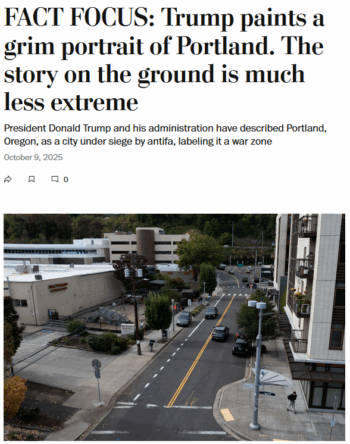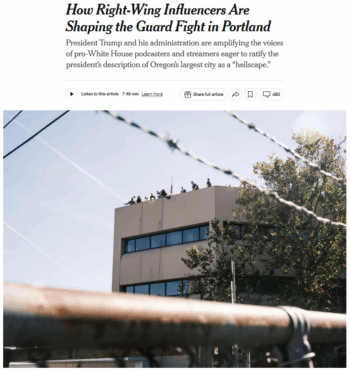
As more and more US cities face the prospect of federal police and military patrolling their streets, the New York Times (10/10/25) began a recent article on the fight over sending National Guard troops to Portland, Oregon, with the following passage:
Democratic leaders in the city and state have pleaded with President Trump and the courts to trust law enforcement records, both local and federal, that describe the demonstrations as small and comparatively calm.
But in the bifurcated media world of 2025, one side’s comparative calm is the other’s “hellscape.”
By “both-sidesing” its description of the protests in Portland, the Times fails to inform its readers that one of these descriptions is true and the other is simply fabricated. Instead, it tells readers the situation reflects “dueling versions of reality.”
Compare this to Michael Tomasky’s reporting in the New Republic (10/13/25), which aptly notes in the kicker that “the disturbances in Portland are basically limited to a single block about two miles from the city center.”
Or the snarky factcheck website Is Portland Burning? which shows images of the serene city and video of a calm, small protest.
Elsewhere, the Times (10/11/25) has written about the funny animal costumes worn by protesters in Portland, reporting that could have been used to debunk MAGA claims that the city is a “hellscape.”
‘Both officials disagree’

Taking a “closer look” at Trump’s claim that “in Portland, Oregon, antifa thugs have repeatedly attacked our offices and laid siege to federal property in an attempt to violently stop the execution of federal law,” AP (via Washington Post, 10/9/25) began its response, “There have been nightly protests outside the US Immigration and Customs Enforcement building in Portland for months, peaking in June when police declared one demonstration a riot.”
In an Associated Press factchecking piece (reprinted in the Washington Post, 10/9/25), promising to take “a closer look at the facts” about Portland, only one of Trump’s claims (that in Portland, “you don’t even have sewers anymore”) is met with a forthright “this is false.” Other times, the AP struggles to find a kernel of truth in the Trump administration’s bizarre claims:
TRUMP: “The amazing thing is, you look at Portland and you see fires all over the place. You see fights, and I mean just violence. It’s just so crazy. And then you talk to the governor and she acts like everything is totally normal, there’s nothing wrong.”
THE FACTS: Fires outside the building have been seen on a handful of occasions.
Or, like the Times, it resorts to both-sidesing it:
KRISTI NOEM, Homeland Security Secretary: “I was in Portland yesterday and had the chance to visit with the governor of Oregon, and also the mayor there in town, and they are absolutely covering up the terrorism that is hitting their streets.”
THE FACTS: Noem did visit Portland on Tuesday and met with Kotek and Mayor Keith Wilson. Both officials disagree with Noem’s narrative.
These failings by the media leave the reader or viewer at the mercy of what are posed as competing narratives, rather than with an understanding of what’s real and what’s fake. This is particularly important now, given that right-wing influencers and media are ginning up false claims for the administration to consume and rebroadcast, and even instigating real incidents (Oregon Public Broadcasting, 10/11/25).
When corporate media refuse to call a lie a lie, and to stand unequivocally on the side of reality, they enable the Trump administration’s growing authoritarianism. If Trump can claim that a major US city is “burning to the ground,” what’s to stop him from asserting that the Constitution allows him to run for a third term—or that, once again, he’s won an election that he actually lost?
Featured Image: Detail from New York Times photo (10/11/25) of Portland protests (photo: Jordan Gale).

